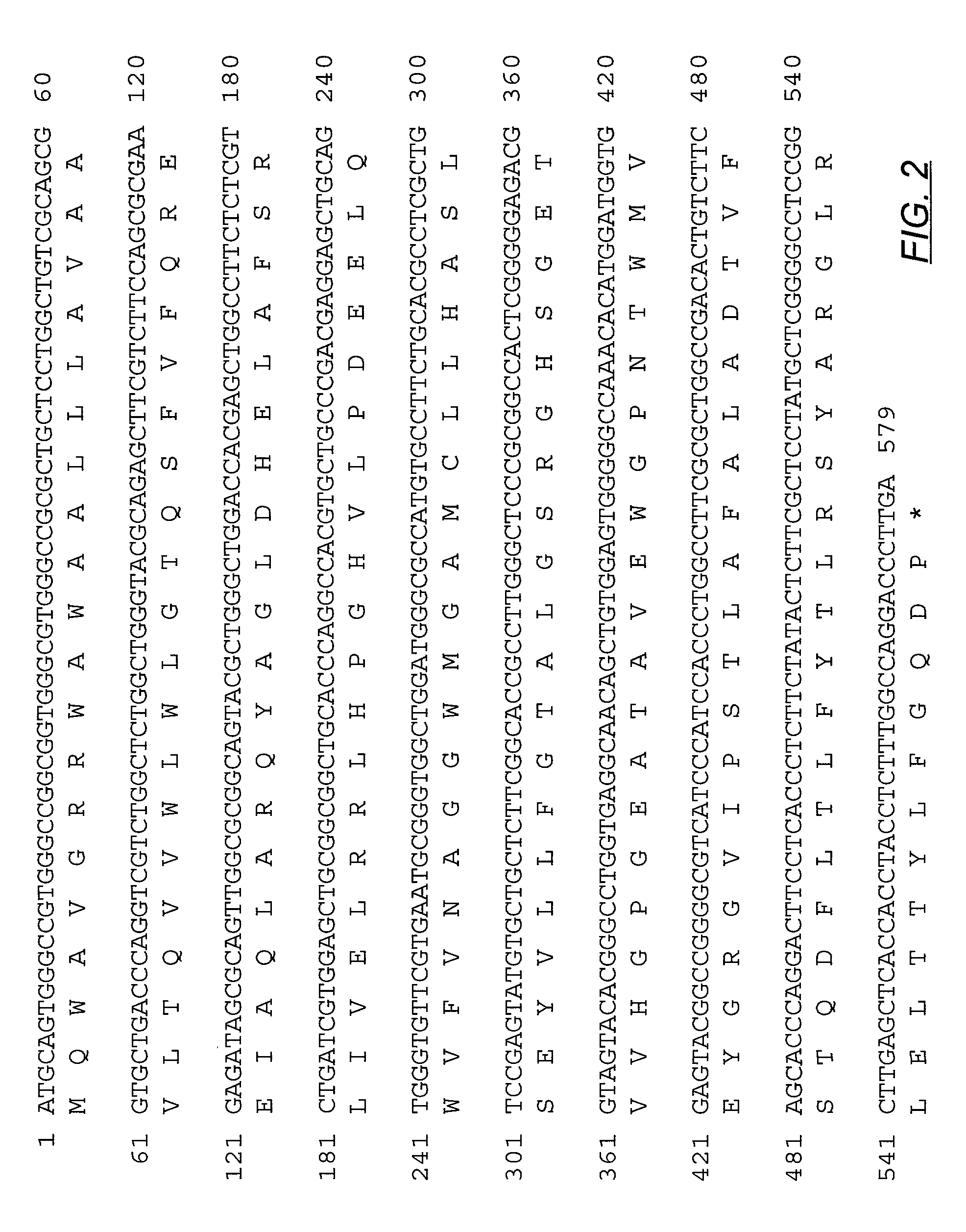Methods and compositions utilizing an alternative splice variant of the sigma-1 receptor
a sigma-1, alternative splice technology, applied in the direction of peptides, drug compositions, peptides, etc., can solve the problems of limited procedure accuracy, tissue sampling by biopsy can be problematic, and tissue samples obtained from tumor biopsy may not be representative of the entire tumor cell population
- Summary
- Abstract
- Description
- Claims
- Application Information
AI Technical Summary
Benefits of technology
Problems solved by technology
Method used
Image
Examples
example 1
Overview of Methods and Results
[0130]Using reverse-transcriptase-polymerase chain (RT-PCR) with flanking σ1-specific primers, the present inventors identified a novel variant in 67 mouse mammary adenocarcinoma cells and in human MCF-breast tumor cells. The cDNA of the variant encodes a 193 amino acid residue protein that is identical to the sequence of the mouse σ1 receptor with the exception of a 90 base-pair in-frame deletion positioned about 18 base pairs downstream of the transmembrane domain. Although the inventors do not wish to be bound to any particular theory of the invention, this deletion occurs at the border of exon 2 and exon 3 and may therefore arise from alternative splicing.
[0131]The splice variant, herein referred to as the receptor σ1B, was cloned into the expression vector pCDNA3 and transfected into COS-1 cells using LIPOFECTAMINE™. Expression of σ1β was assessed by binding to either [3H](+)-pentazocine (σ1-like binding) or [3H]DTG plus cold pentazocine (σ2-like ...
example 2
RT-PCR and Cloning of Novel Variant
[0132]Total RNA was isolated form 67 mouse and MCF-7 human breast cells. The following primers were used for RT-PCR using the GeneAmp
[0133]
Upstream primer:5′-GAACGAATTCAGAAGTCCGTGGGCCGCGGGA-3′[SEQ ID NO: 5]Downstream primer:5′-TAACGGTACCTCAGGAGTCTTGGCCAAAGAG-3′[SEQ ID NO: 6]
[0134]The RT-PCR products were separated on an agarose gel, shown in FIG. 1. The numbers to the left of the gel indicate number of base pairs (bp=base pairs); the lane marked “M” are size-markers; the lane labeled 67 is are the RT-PCR products isolated from the mouse cells; the lane marked MCF-7 indicates the RT-PCR products isolated from the human breast tumor cells. The 600 base-pair products were isolated from the agarose gels. The RT-PCR products were directionally cloned into the pCMV-5 vector. The products were then sequenced.
[0135]The mRNA sequence (cDNA sequence) of human σ1β was determined. The sequence has GenBank Accession Number AF226604 and is set forth in FIG. 2 an...
example 3
Expression of the σ1β Receptor in COS-1 Cells
[0145]The 600 bp RT-PCR products of Example 2 were subcloned into pcDNA3 vectors. COS-1 cells were then transfected with either an empty pcDNA3 vector or the pcDNA3-cDNA construct using the LIPOFECTAMINE™ reagent.
PUM
| Property | Measurement | Unit |
|---|---|---|
| temperature | aaaaa | aaaaa |
| temperature | aaaaa | aaaaa |
| length | aaaaa | aaaaa |
Abstract
Description
Claims
Application Information
 Login to View More
Login to View More - R&D
- Intellectual Property
- Life Sciences
- Materials
- Tech Scout
- Unparalleled Data Quality
- Higher Quality Content
- 60% Fewer Hallucinations
Browse by: Latest US Patents, China's latest patents, Technical Efficacy Thesaurus, Application Domain, Technology Topic, Popular Technical Reports.
© 2025 PatSnap. All rights reserved.Legal|Privacy policy|Modern Slavery Act Transparency Statement|Sitemap|About US| Contact US: help@patsnap.com



